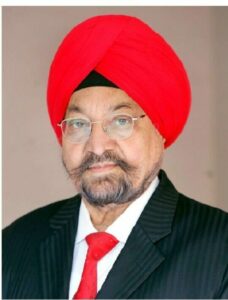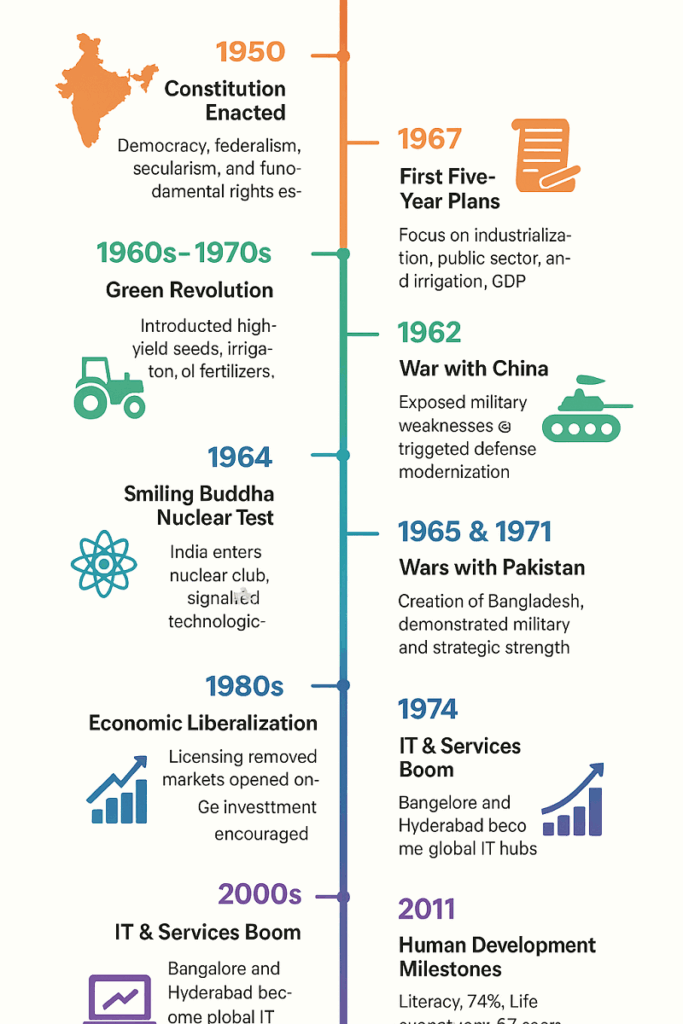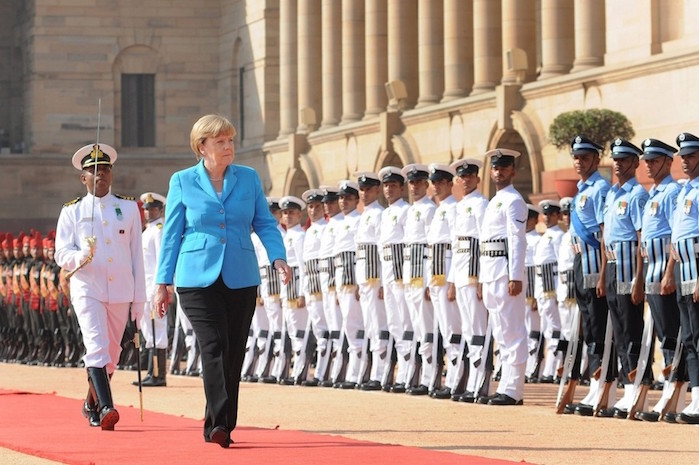By 2014, before the Modi government came to power, India’s GDP had reached nearly $2 trillion, the 10th largest in the world, with foreign reserves of $300 billion. Telecom penetration had exploded, highways expanded, and privatized airports transformed city skylines. A once destitute land now stood as a rising economic power.
“To claim that India was stagnant for seventy years before 2014 is to rewrite history. The Green Revolution, the IT revolution, liberalization, space exploration, and nuclear power were achievements of earlier eras. Poverty reduction, literacy gains, and rising life expectancy were the result of decades of collective effort.”
“The myths of sudden greatness may serve short-term politics, but the truth is more powerful: India’s destiny has been shaped not by one decade or one leader, but by the collective endurance of its people.”

In May 2014, the Bharatiya Janata Party (BJP) under Narendra Modi stormed to power on the promise of a “New India.” The campaign narrative was dramatic: the nation had supposedly wasted seventy years under Congress and other governments in corruption, drift, and poverty, and only under Modi would India rise to greatness. For millions of frustrated voters, weary of scams and inflation, that story was compelling. But it was also misleading. To accept it uncritically is to erase the extraordinary journey that India has traveled since 1947.
India’s rise is not the miracle of one leader or one party. It is the long, uneven, but unmistakable climb of a nation that began life among the world’s poorest states and, through seven decades of collective struggle, emerged as a major global player.
1947: Freedom in Ruins
When the Union Jack came down on August 15, 1947, India was free but fractured. Partition had displaced nearly 14 million people and killed over a million in horrific communal violence. Refugees poured into makeshift camps; trains carrying corpses crossed the new borders.
The economic picture was equally bleak. Per capita income was about ₹250 a year (roughly $50). Life expectancy was 35 years. Literacy stood below 20%. Agriculture was primitive and unable to feed the population. Famines had claimed millions of lives, most recently in Bengal in 1943.
Infrastructure, too, was skeletal. Fewer than 1,500 villages had electricity. India inherited 53,000 kilometers of railways, but they had been designed for extraction, not integration. Industry contributed barely 10% of GDP. Globally, India’s share of output had collapsed from 23% in the 18th century to around 3% at independence.
The world doubted India’s survival. Winston Churchill predicted disintegration, and American journalists dismissed it as a “basket case.” The challenge of building a secular, democratic, and united country out of such poverty and diversity seemed nearly impossible.
Laying the Foundations
Jawaharlal Nehru and the Constituent Assembly chose democracy over dictatorship and pluralism over sectarianism. The Constitution of 1950 was one of the most ambitious in the world, guaranteeing universal suffrage, federalism, and fundamental rights.
In the 1950s and 60s, India invested heavily in institutions: the Election Commission, the Supreme Court, the Planning Commission, and the Indian Administrative Service. Nehru’s vision emphasized science and industry: steel plants at Bhilai, Rourkela, and Durgapur; the Bhakra Nangal Dam; IITs, AIIMS, and national laboratories.
Growth was slow — the infamous “Hindu rate” of around 3%. Licensing and bureaucratic controls bred inefficiency. Food shortages were chronic, forcing dependence on American PL-480 wheat imports. Yet, India survived as a democracy, while many post-colonial states slid into coups and dictatorships. That survival alone was no small achievement.
Green Revolution and Wars
The 1960s and 70s tested India repeatedly. The humiliating defeat to China in 1962 exposed military weakness, but wars with Pakistan in 1965 and 1971 showcased determination. The 1971 victory reshaped South Asia, leading to the creation of Bangladesh.
At home, the Green Revolution transformed agriculture. With high-yield seeds, irrigation, and fertilizer, wheat production surged, ending chronic shortages. By the 1980s, India was largely self-sufficient in food.
There were darker chapters too. The Emergency (1975–77) suspended democratic rights and censored the press. But India’s voters proved resilient, ousting Indira Gandhi in 1977 and restoring democracy. Few developing nations bounced back from authoritarianism so quickly.
1991: Liberalization and Takeoff
By the late 1980s, India was again in economic distress. Growth lagged, deficits ballooned, and a foreign exchange crisis loomed. In 1991, Prime Minister P. V. Narasimha Rao and Finance Minister Manmohan Singh launched sweeping reforms: dismantling licenses, cutting tariffs, and opening markets.
This liberalization was a turning point. Growth accelerated to 6–8% annually over the next two decades. The IT services revolution, led by Infosys, TCS, and Wipro, turned Bangalore into a global hub. Foreign investment surged, exports expanded, and a confident middle class of 300 million emerged.
The transformation was visible in human development. Literacy rose from 12% in 1947 to 74% by 2011. Life expectancy doubled. Poverty, once above 70%, fell to around 22%. Diseases like polio were eradicated. India joined the club of spacefaring nations and, in 2013, placed a probe into orbit around Mars on its first attempt, stunning the world with cost efficiency.
India on the World Stage
India’s diplomacy evolved with its growth. A leader of the Non-Aligned Movement during the Cold War, it later became a member of G20, BRICS, and a sought-after strategic partner. Nuclear tests in 1998 established India as a de facto nuclear power, and the 2008 Indo-U.S. Civil Nuclear Agreement recognized its status.
By 2014, before the Modi government came to power, India’s GDP had reached nearly $2 trillion, the 10th largest in the world, with foreign reserves of $300 billion. Telecom penetration had exploded, highways expanded, and privatized airports transformed city skylines. A once destitute land now stood as a rising economic power.
India’s Historic Journey: Key Milestones
2014 and Beyond: Continuity, Not Creation
This was the India the BJP inherited in 2014 — dynamic but troubled, with corruption scandals and slowing growth under the UPA years. Modi’s government accelerated infrastructure building, digitization, and foreign policy assertiveness. Schemes like Ayushman Bharat (health insurance) and Ujjwala Yojana (LPG connections) reached millions. ISRO achieved new milestones with Chandrayaan-3 and Aditya-L1.
But the record is mixed. Demonetization in 2016 disrupted livelihoods without eliminating black money. The GST rollout was chaotic. The pandemic exposed fragile health systems. Youth unemployment has remained stubborn, and inequality has widened.
Politically, India has faced growing concerns about democratic backsliding — shrinking press freedom, partisan use of investigative agencies, and majoritarian rhetoric. International indices like Freedom House and V-Dem have downgraded India’s democratic rankings.
Myths and Realities
To claim that India was stagnant for seventy years before 2014 is to rewrite history. The Green Revolution, the IT revolution, liberalization, space exploration, and nuclear power were achievements of earlier eras. Poverty reduction, literacy gains, and rising life expectancy were the result of decades of collective effort.
The BJP has added its imprint, but it did not create prosperity out of a vacuum. It stands on foundations built by generations of Indians — farmers, scientists, entrepreneurs, teachers, and ordinary citizens — who struggled through scarcity to build capacity.
The Road Ahead
India today is the world’s fourth largest economy, with unmatched potential. But challenges remain: ensuring equitable growth, strengthening education and health, protecting democratic pluralism, and addressing inequality. Propaganda cannot substitute for policy, nor can political myth-making erase the sacrifices of earlier decades.
The real story of India’s rise is not a Modi miracle, nor a Nehru legacy alone. It is the cumulative triumph of a people who refused to accept despair. From the shattered land of 1947 to the confident republic of today, India’s journey has been long, uneven, and unfinished.
The myths of sudden greatness may serve short-term politics, but the truth is more powerful: India’s destiny has been shaped not by one decade or one leader, but by the collective endurance of its people.
(The author welcomes comments)





Be the first to comment